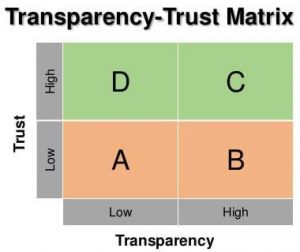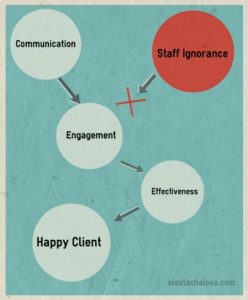It can take years to master the digital marketing industry’s many nuances.
Having a solid technical and marketing background isn’t enough to make you an industry expert. As well as acquiring deep digital marketing expertise and knowledge, you need to know how to tailor your business position and communications to be perceived as a professional by potential clients.
You must not only be sure of your capabilities yourself, but you must also be able to convince your clients, colleagues and bosses that you are capable.
In this article, I want to share 5 rules you should master to sell your SEO ideas.
Rule #1: Be on the same page as your client
If you want to build a lasting relationship with your client, you have to reach a mutual understanding. This means you have to speak their language.
So our first rule starts with bearing in mind that your and your clients’ perspectives will not typically coincide.
That is normal, as long as you can maintain a balance between performance and results. While it is essential for your professional growth to focus on processes, you need to remember that your clients are more interested in seeing results.
There are two types of metrics – performance metrics and result metrics. As long as you focus on your own process and constantly move forward, you will be able to select the appropriate metrics to monitor your progress.
But your clients and managers are interested in results, so you should include metrics that highlight the benefits of that progress in your reports for them. As usual, your clients focus on the bottom line;. include KPIs, conversion rates, and other metrics that clients understand.
Unless your clients ask about other results, don’t everyone’s time with performance metrics they might not be aware of, nor use obscure SEO terminology. You don’t want to make them feel uncomfortable by highlighting their lack of knowledge.
Again, you should speak their language; express success using details they care about. Below you can see a schema for common performance and business metrics.
Some clients want every detail shared, others just the top line of major developments and results. Your aim should always be precision and reassuring clients that they are not wasting their money, which takes us to my next rule.
Rule #2: Your processes must be measurable and transparent for all involved parties
Always be open with your clients. Although it is true that your results speak for themselves, it is your job to elucidate them. They should be measurable and transparent, so you need to find the right tools and techniques to best depict your progress.
Let’s take a look at the following matrix, usually applied to agency-client relationships. It explains the correlation between the transparency of a company’s inner processes and the level of trust this company receives from its clients.

Your relationship with your client begins at point A. They are not aware of what is going on inside your company or how you will deliver the services they pay for.
Your aim is to be as transparent for your customers as possible. Provide them with reports and metrics that will help them understand your process. It is a good idea to use specials tools to create an all-in-one, automated reports. There are many such tools which will help you create awesome reports – more on those later.
These tools and reports are the keys to moving from point A to point B while providing your clients with the information they need to feel confident about your progress. You then have the credibility to move to Point C while your client receives step-by-step reporting that shows delivered work and quantified results. Using tools that provide super-detailed, relevant reports, you will teach your clients to have more and more trust in you.
At some point, your clients will stop checking your process on a regular basis. They will no longer need to be in control of everything because they will trust you. Your relationships will then arrive at point D, where you can be less transparent while still maintaining your clients’ trust.
This is the most comfortable position for both sides, as you will no longer need to spend resources on extra reporting, and your clients will not need to constantly check your progress. But, you will still need to track all your work completed, because there is always a risk of failure and you want detail to maintain the high level of trust in your relationship.
Whatever activity it is – from a site audit to tracking backlinks, brand mentions and keyword positions – you can always find tools to track performance and provide you statistics for your reports.
Tools:
For tracking keyword positions you can use Advanced Web Ranking, SEOmonitor, and a choice of other tools. I use Semrush a lot because it offers a competitive landscape report that is informative and easy to read, and you can use it to assess your local competition.
Also, AccuRanker is a tool that provides super-fast data updates and tracks the top 500 sites ranking for given keywords in SERPs, which I think is a huge competitive advantage.
Position tracking tools help you better understand your SEO progress and provide your clients with all necessary reports.
For technical site audits, I recommend the following tools: Raven Tools, WebCEO, OnCrawl, and DeepCrawl. With the help of these tools, you will be able to discover mistakes that could send confuse search engines and monitor improvements. Use them to check on-page features (such as titles and meta-descriptions), find broken links, duplicate content issues and a lot more.
For backlinks and web mention reporting, I would suggest Ahrefs, Majestic, CognitiveSEO and BrandMentions. As an example, you can use Content Alert reports in BuzzSumo to examine your brand. This shows you changes in brand mention rates over a selected period of time, as well as a list of domains which have mentioned the brand you have interest in.
So, precision and transparency will build lasting relationships with your clients. Another issue I would like to focus on is educating your clients. In a majority of cases, your customers simply won’t be into SEO. So, you will only be able to establish long-term relationships with them if you are able to explain how your services will contribute to their company’s success. So, let’s tackle educating clients next.
Rule # 3: Educate your clients; motivate your employees to communicate and cooperate
It is a well-known fact that to close a deal and maintain a lasting relationship, you need to educate your clients. And you can organise training sessions and tutorials to instruct them on core principles, processes and essential metrics they should be aware of.
But make sure you provide them with this information in small doses. To lead an effective educational session, you should prepare to explain the professional nuances of digital marketing and SEO activities in terms that will be intelligible. Your clients are not specialists – they come to you because you are. In fact, if you confuse them with difficult explanations, there is a high probability that you will lose their trust.
Apart from educating your clients, it is important to educate your colleagues as well. When you don’t know what’s going, you can’t weigh the importance of a process, and it’s easy to see little value in other people’s work.
In the digital marketing sphere, it’s easy to imagine PPC and SEO departments having little knowledge of or respect for the opposite department’s input.
So, education is important because it often resolves such communication issues. Why is communication so important, you might ask? Take a look at Yves Morieux’s insightful video “As work gets more complex, 6 rules to simplify.”
He explains how good communication within a company leads to a higher level of engagement from all participants, and, thus, increased effectiveness. Drawing on his vast management experience, Yves concludes that a common source of engagement problems is staff ignorance.

So, what is the solution? To communicate effectively with your colleagues, you should always educate them on what you are doing. Create easy-to-read reports and make sure to include data they can understand, even if they are not involved in the part you are responsible for. It is essential to be as clear and transparent as possible.
You should make every effort to make your customers happy, but only your departments’ cooperation can make this a reality.
What makes your pitch even more powerful? I would say that this list would be incomplete without mentioning your data-driven approach. And that brings us to our next rule.
Rule #4: Make your pitches data-driven
A data-driven approach will help you reinforce your pitches with actual data, and this makes your words not just your opinion, but professional expertise.
The key? You should be very specific, very comprehensive, and provide your clients with up-to-date data.
With the help of some of the great tools available, you can point out the weak and strong sides of current marketing efforts, as well as compare a site’s performance with major competitors and industry benchmarks.
There are plenty of tools that will help you not only to collect all the important data you need but present that data in an easy-to-read, graphical way. Among my favourites are SpyFu, Searchmetrics, SERPstat, SEMrush, and KeywordSpy. With the help of these, you will be able to watch your clients’ progress and audit their competitors as well.
And this is a big deal! From my own experience, I can assure you that without knowing your (or your clients’) competitive landscape, you cannot run a successful SEO campaign. Often, clients are unaware of their online competitors, and this is something you should educate them about. Using a data-driven approach is essential for making your argument persuasive. For example, in the following screenshot, you can see a SERPstat report on the competitive landscape for the domain Frenchconnection.com.
If your report presents information intelligently, you will find a way to your clients’ heart.
Another powerful competitive intelligence tool that I like is SimilarWeb, which estimates traffic sources and provides you with insights into your competitors’ marketing strategies. Also, it gives a ranked list of a site’s competitors. In the following screenshot, you can see a Similarweb report on competitor sites similar to your site.
But in addition to the data itself, you should pay no less attention to how it is presented. My last piece of advice is to think carefully about the best way to prepare your reports. Think about them beforehand and build them with all the important fundamental elements in place – this is the next rule to follow.
Rule #5: Use pre-built templates for reports
Reporting is a routine part of the digital marketer’s life. You have to prepare both internal and external reports. I advise that you use prebuilt templates; from my personal experience, they save a lot of time.
For organizing your reports, using Google Drive is a good idea. If you use the tools mentioned in sections above for getting data for your reports, you can also use these tools’ APIs to update some data automatically. I also advise that you use pivot tables if you aren’t already. Pivot tables are Excel’s most useful feature, designed especially for working with large data sets; they allow you to update numbers by updating the source data of a previously created pivot table.
Additionally, you can use Cyfe, Raven Tools, Klipfolio or Domo – I simply love all of these tools for their easy report-building features. They’re also well-designed tools with the help of which you can create comprehensive dashboards to track all your business data.
In general, using prebuilt reports and templates can help you a lot, because they save time, make your data not only more stylish but more intelligible and can help reinforce your brand.
In summary, following the rules I’ve discussed in this piece will help you and your company accomplish your marketing goals. A professional approach and proper communication are both at the heart of every success story.


